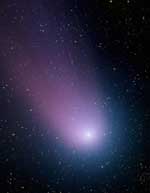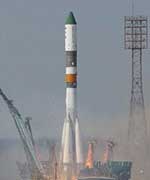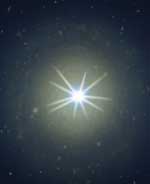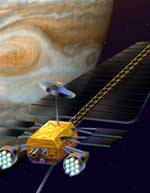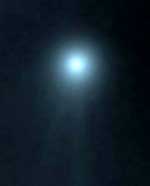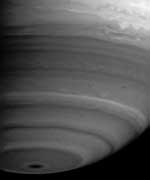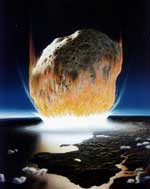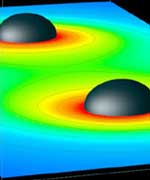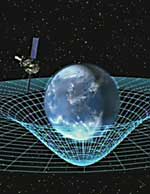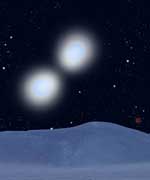
Image credit: Harvard-Smithsonian CfA
About 20,000 light-years from Earth, two massive stars grapple with each other like sumo wrestlers locked in combat. Both giants, each weighing in at around 80 times the mass of our Sun, are the heaviest stars ever. They orbit each other every 3.7 days, nearly touching as they spin on the celestial stage. And they lead tempestuous lives worthy of any Hollywood couple, blasting each other with hot, violent stellar winds.
“We could not resist exploring this system because it’s so remarkable. It’s a place of true extremes,” said astronomer Alceste Bonanos (Harvard-Smithsonian Center for Astrophysics).
The binary star system Bonanos studied, known as WR 20a, was pegged as particularly interesting only weeks ago by a team of European researchers headed by Gregor Rauw. That team’s spectroscopic observations showed that both stars were very massive. However, the only way to determine the masses precisely was to establish at what angle we were viewing the system, as well as the orbital period.
Bonanos and her advisor, Krzysztof Stanek (CfA), requested photometric observations from the Optical Gravitational Lensing Experiment (OGLE) team led by Andrzej Udalski (Warsaw University Observatory). Bonanos and Stanek knew that if the system were nearly edge-on, one star would periodically pass in front of, or eclipse, the other. Fortuitously, those eclipses were detected by the OGLE group, thereby firmly establishing the characteristics of the system.
“When we realized how important it would be to obtain an accurate light curve for WR 20a, we immediately decided to contact Andrzej Udalski, who leads the Polish project known as OGLE. They are a premier facility for optical surveys, and we were very happy when they agreed to collaborate on this project,” said Stanek.
Observations were collected in May 2004 with the 1.3-meter-diameter OGLE telescope at the Las Campanas Observatory in Chile.
“The results have exceeded our expectations; after just two nights, we realized that the star significantly changed its brightness, and after a few more we were certain that the system is eclipsing,” said Udalski.
“After obtaining data each night for more than two weeks, we were able to measure very accurately the period, inclination angle, and hence the masses of the two stars,” added Stanek.
A System Of Extremes
WR 20a is part of the Westerlund 2 star cluster, which resides in a region of ionized hydrogen left over from the cluster’s formation in the constellation Carina. WR 20a contains two hot, young Wolf-Rayet stars-a type of star that is extremely rare and short-lived.
“Wolf-Rayet stars are likely progenitors of the extremely powerful explosions known as gamma-ray bursts,” said Bonanos. “These stars are already 2 or 3 million years old. In another few million years, whichever one is slightly more massive will undergo core collapse and blast off its outer layers. The companion star likely will survive despite its nearness, at least until it goes supernova sometime later.”
While other stars, such as the Pistol Star and eta Carinae, are suspected of containing enough material to make more than 100 Suns, their masses have not been determined accurately. The possibility exists that they are simply very close binaries. WR 20a is the most massive known binary system where both stars have precisely determined masses.
“It is important to study and understand these massive stars because they probe the realm of the first stars that formed in the Universe. Learning more about this system will help improve star formation models, as well as increase our understanding of the connection of these stars to supernovae and gamma-ray bursts,” said Stanek.
This research has been posted online at http://arxiv.org/abs/astro-ph/0405338 in a paper co-authored by Alceste Bonanos and Krzysztof Stanek (CfA); with Andrzej Udalski, Lukasz Wyrzykowski, Karol Zebrun, Marcin Kubiak, Michal Szymanski, Olaf Szewczyk, Grzegorz Pietrzynski, and Igor Soszynski (Warsaw University Observatory).
Headquartered in Cambridge, Mass., the Harvard-Smithsonian Center for Astrophysics is a joint collaboration between the Smithsonian Astrophysical Observatory and the Harvard College Observatory. CfA scientists, organized into six research divisions, study the origin, evolution and ultimate fate of the universe.
Original Source: Harvard CfA News Release
